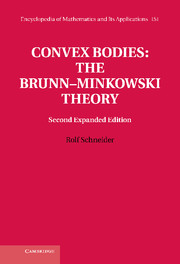Book contents
- Frontmatter
- Contents
- Preface to the second edition
- Preface to the first edition
- General hints to the literature
- Conventions and notation
- 1 Basic convexity
- 2 Boundary structure
- 3 Minkowski addition
- 4 Support measures and intrinsic volumes
- 5 Mixed volumes and related concepts
- 6 Valuations on convex bodies
- 7 Inequalities for mixed volumes
- 8 Determination by area measures andcurvatures
- 9 Extensions and analogues of theBrunn–Minkowski theory
- 10 Affine constructions and inequalities
- Appendix Spherical harmonics
- References
- Notation index
- Author index
- Subject index
8 - Determination by area measures and curvatures
Published online by Cambridge University Press: 05 December 2013
- Frontmatter
- Contents
- Preface to the second edition
- Preface to the first edition
- General hints to the literature
- Conventions and notation
- 1 Basic convexity
- 2 Boundary structure
- 3 Minkowski addition
- 4 Support measures and intrinsic volumes
- 5 Mixed volumes and related concepts
- 6 Valuations on convex bodies
- 7 Inequalities for mixed volumes
- 8 Determination by area measures andcurvatures
- 9 Extensions and analogues of theBrunn–Minkowski theory
- 10 Affine constructions and inequalities
- Appendix Spherical harmonics
- References
- Notation index
- Author index
- Subject index
Summary
The theory of mixed volumes is a powerful tool for treating some questions on closed convex hypersurfaces from the point of view of differential geometry, but in a general form without differentiability assumptions. Under smoothness assumptions, the results we have in mind concern the determination of closed convex hypersurfaces from curvature functions, such as Gauss curvature, mean curvature and their generalizations. Here ‘determination’ comprises questions of existence, uniqueness and stability. Without differentiability assumptions, the usual curvature functions, namely the elementary symmetric functions of the principal curvatures on the boundary of a convex body or of the principal radii of curvature on the spherical image, have to be replaced by curvature measures and area measures, respectively. The area measures are particularly accessible to the Brunn–Minkowski theory. In Section 8.1 we treat uniqueness theorems for these. Section 8.2 is devoted to Minkowski's existence theorem for convex bodies with given surface area measure (area measure of order n – 1) and Section 8.3 deals with area measures of order one, where the existence problem is known as the Christoffel problem. The intermediate cases, area measures of orders strictly between 1 and n – 1, are briefly considered in Section 8.4. The final section is devoted to corresponding stability estimates and to a few uniqueness results for curvature measures.
Uniqueness results
We start with the uniqueness assertion for the determination of a convex body by its surface area measure. Although this result will be improved and generalized by later theorems, we give its formulation and proof separately, to show in a basic example the close connection with results on mixed volumes.
- Type
- Chapter
- Information
- Convex Bodies: The Brunn–Minkowski Theory , pp. 447 - 488Publisher: Cambridge University PressPrint publication year: 2013

